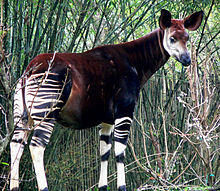Okapi
| Okapi | |
|---|---|
 |
|
| An okapi at Disney's Animal Kingdom in Florida. | |
| Scientific classification | |
| Kingdom: | Animalia |
| Phylum: | Chordata |
| Class: | Mammalia |
| Order: | Artiodactyla |
| Family: | Giraffidae |
| Genus: |
Okapia Lankester, 1901 |
| Species: | O. johnstoni |
| Binomial name | |
|
Okapia johnstoni (P.L. Sclater, 1901) |
|
The okapi (/oʊˈkɑːpiː/; Okapia johnstoni) is a giraffid artiodactyl mammal native to the northeast of the Democratic Republic of the Congo in Central Africa. Although the okapi bears striped markings reminiscent of zebras, it is most closely related to the giraffe. The okapi and the giraffe are the only living members of the family Giraffidae. The okapi stands about 1.5 m (4.9 ft) tall at the shoulder and has an average body length of about 2.5 m (8.2 ft). Its weight ranges from 200 to 350 kg (440 to 770 lb). It has a long neck, and large, flexible ears. Its coat is a chocolate to reddish brown, much in contrast with the white horizontal stripes and rings on the legs and white ankles. Male okapis have short, hair-covered horns called ossicones, less than 15 cm (5.9 in) in length. Females possess hair whorls, and ossicones are absent.
Okapis are primarily diurnal but may be active for a few hours in darkness. They are essentially solitary, coming together only to breed. Okapis are herbivores, feeding on tree leaves and buds, grasses, ferns, fruits, and fungi. Rut in males and estrus in females does not depend on the season. In captivity, estrous cycles recur every 15 days. The gestational period is around 440 to 450 days long, following which usually a single calf is born. The juveniles are kept in hiding, and nursing takes place infrequently. Juveniles start taking solid food from three months, and weaning takes place at six months.
Okapis inhabit canopy forests at altitudes of 500–1,500 m (1,600–4,900 ft). They are endemic to the tropical forests of the Democratic Republic of the Congo, where they occur across the central, northern and eastern regions. The International Union for the Conservation of Nature and Natural Resources (IUCN) classifies the okapi as Endangered. Major threats include habitat loss due to logging and human settlement. Extensive hunting for bushmeat and skin and illegal mining have also led to a decline in populations. The Okapi Conservation Project was established in 1987 to protect okapi populations.
...
Wikipedia

